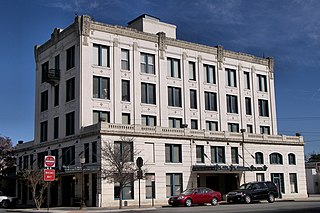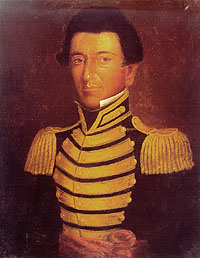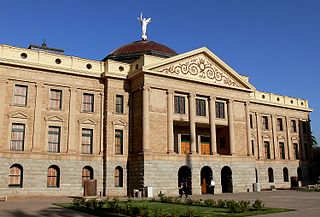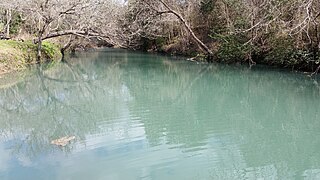
Guadalupe County is a county located in the U.S. state of Texas. As of the 2020 census, its population was 172,706. The county seat is Seguin. The county was founded in 1846 and is named after Guadalupe River.

Seguin is a city in and the county seat of Guadalupe County, Texas, United States; as of the 2020 census, its population was 29,433. Its economy is primarily supported by a regional hospital, as well as the Schertz-Seguin Local Government Corporation water-utility, that supplies the surrounding Greater San Antonio areas from nearby aquifers as far as Gonzales County. Several dams in the surrounding area are governed by the main offices of the Guadalupe-Blanco River Authority, headquartered in downtown Seguin.

Juan Nepomuceno Seguín was a Spanish-Tejano political and military figure of the Texas Revolution who helped to establish the independence of Texas. Numerous places and institutions are named in his honor, including the county seat of Seguin in Guadalupe County, the Juan N. Seguin Memorial Interchange in Houston, Juan Seguin Monument in Seguin, World War II Liberty Ship SS Juan N. Seguin, Seguin High School in Arlington.

James Riely Gordon was an architect who practiced in San Antonio until 1902 and then in New York City, where he gained national recognition. J. Riely Gordon is best known for his landmark county courthouses, in particular those in Texas. Working during the state's "Golden Age" (1883–1898) of courthouse construction, Gordon saw 18 of his designs erected from 1885 to 1901; today 12 remain.

Sebastopol House Historic Site is an antebellum Greek Revival house built of concrete, located in Seguin, Texas, United States. Joshua W. Young built it between 1854 and 1856 for his sister, Catherine LeGette. Today Sebastopol is one of some 20 surviving buildings that give Seguin the largest concentration of early 19th century structures in the U.S.

Matthew Caldwell,, also spelled Mathew Caldwell was a 19th-century Texas settler, military figure, Captain of the Gonzales – Seguin Rangers and a signer of the Texas Declaration of Independence. Because of his recruitment ride ahead of the Battle of Gonzales, some call him the Paul Revere of Texas.
James Milford Day was a 19th-century Texas military figure. He was a member of Mathew Caldwell's and Jack Hay's Seguin Rangers and a participant in the Mexican–American War.

Ferdinand C. Weinert was a merchant and politician from Seguin, Texas, who served in the Texas Legislature, four years in the Senate and four terms in the House, and well as serving as Secretary of State.
Arthur Swift (1812–1855) was a 19th-century Texas merchant, surveyor, political and military figure. He along with Rangers Mathew Caldwell and James Campbell were founders of Seguin, Texas and a member of Callahan's Gonzales-Seguin Rangers and a participant in the Texas–Indian wars. He served as a Texas State Representative for Gonzales-Guadalupe County.
Andrew Jackson Sowell was a lifelong soldier and farmer in the 19th century. He was a participant in the Texas Revolution and a survivor of the siege of the Alamo. He continued his service during the years of the Republic of Texas, in the Mexican–American War, and the Civil War. He was a frontier defender, early Texas Ranger, and a friend and scout with Kit Carson.

Hardscramble is the name given to an early 1800s stone structure located near Seguin, Texas, that was used as a home station by some of the earliest and most famous of Texas Rangers.

The Robert Hall House is a historic 1830s home on the Walnut Branch. The house was the residence of the early ranger, Robert Hall (1814–1899). It is among the oldest structures still standing in Seguin, Texas.
Cottonwood Creek is a stream in South Central Texas, United States that runs approximately 9 miles from its source five miles east of New Berlin, Texas, to its confluence with the Guadalupe River in Guadalupe County, Texas, four miles southeast of Seguin. The creek serves as a tributary of the Guadalupe River and forms its watershed near Seguin, Texas. There is a separate Cottonwood Creek that flows through northern Guadalupe County before discharging into the San Marcos River above Kingsbury.

Geronimo Creek is a stream in South Central Texas, U.S., that runs approximately 17 miles, from its source one mile east of Clear Springs, Texas, to its confluence with the Guadalupe River in Guadalupe County, Texas, three miles southeast of Seguin.
Schumansville is a historic German settlement in Guadalupe County, Texas, United States. It is an unincorporated community.
Elm Creek is the name of two separate streams that rise in Guadalupe County southwest of Seguin in South Central Texas, United States. The western Elm Creek runs approximately 14 miles from its source about 8.6 miles southwest of Seguin in southwestern Guadalupe County, to its confluence with Cibolo Creek, two miles east of La Vernia in Wilson County. The eastern Elm Creek originates 9.4 miles southwest of Seguin, and proceeds southeast through Guadalupe County, where it discharges into Cottonwood Creek, which itself flows into the Guadalupe River.
John Esten Park,, educated in chemistry and medicine, experimented with using concrete to construct buildings before the American Civil War. His work left the town of Seguin, Texas, with a large concentration of 19th-century concrete structures.

The Magnolia Hotel is a historic structure located in Seguin, Texas. It was in operation as a hotel as early as 1844. The building had been in poor repair for a number of years and was added to a list of the most endangered historic places in Texas in 2012. In 2013, the structure came under new ownership and was being restored for use as a private residence.
















